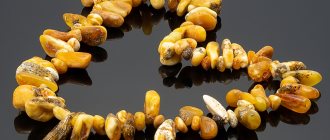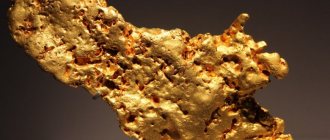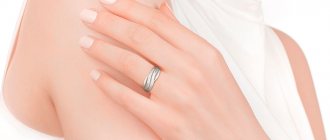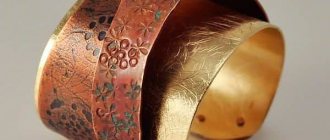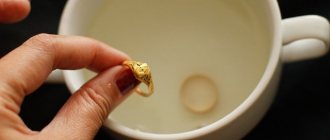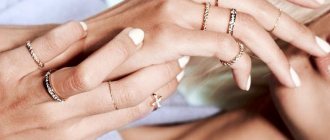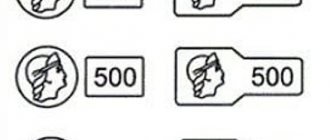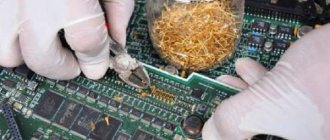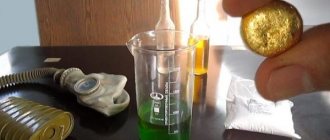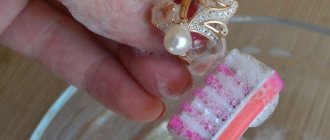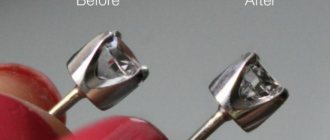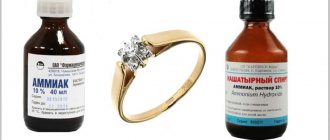Look at the sample
Factory products always have a standard stamp with a hallmark. Fineness is the number of grams of pure metal in the alloy; the lower it is, the worse the quality.
According to Decree of the Government of the Russian Federation dated May 6, 2021 No. 394, all alloys in which more than 30% of the weight is precious metal must be stamped with hallmark. Standard samples for gold are 375 (lowest), 500, 583, 585, 750, 916, 958, 999 (highest - only 1 g of impurities per 1 kg of metal).
In the USA and Canada, carat hallmarks are used (9 carats correspond to the 375th hallmark, 24 carats correspond to the 999th). Moreover, the letter K next to the numbers means that the product itself is gold, and KGP means that it is plated with gold (karat gold plated).
In Belgium, gold samples are designated by numbers: 1 – 833, 2 – 750, 3 – 585. A similar system works in the Czech Republic and Slovakia: 0 – 999, 1 – 986, 2 – 900, 3 – 750, 4 – 585.
Examining a sample is often difficult. Use your smartphone in macro mode, then enlarge the photo and look at the sample in detail. The mark should not be crooked or blurry. This is, if you like, a passport of the product, so they are very careful when applying it.
How to determine the gold standard yourself?
Gold is mixed with other metals to give the jewelry strength, because on its own it is too soft and the jewelry will not be strong enough. Alloys are sometimes created in order to diversify the color range of the range of products - the result is jewelry with pink, reddish and even greenish hues.
You need to understand! The test shows the ratio of precious metal with impurities in the jewelry; this is a three-digit number stamped on the surface of the product. In Russia, the 585 standard is common, and others have also been established: 375, 500, 583 750, 950, 999. The number 585 means that the product contains 58.5% gold, everything else is an admixture of other metals. The deception in the production of jewelry lies in the lower gold content than required by the carved sample.
How to determine the gold standard at home?
After testing the product for authenticity, you can check how much gold is present in it, that is, find out its fineness. This can be found out in the following ways:
- drop method using a chemical reagent;
- a special device;
- assay analysis.
Drip method
The difficulty of using this method to carry out it at home lies in the lack of necessary experience to complete the process. In addition, you need to purchase chemical reagents, but they are usually available and sold in specialized jewelry stores . Moreover, the method is recognized as one of the most reliable.
Various types of reagents are used to determine the sample:
- acidic;
- chlorine gold (for 585 standard);
- potassium iodide.
The reagent is applied to a small surface cleaned with a file. After waiting about a few seconds, you will need to evaluate the change in the color of the gold.
- 585 sample - light brown color;
- 375 standard - green color.
The darker the remaining color, the lower the grade.
Determination by device
An electronic detector allows you to quickly and accurately determine the gold standard at home . The device can easily distinguish where the gold-plated fake is and where the genuine product is, giving out the exact gold content in it. The data will be shown in carats, which will allow you to calculate the sample number.
✅ RECOMMENDED: 12 places where you can hide money in your apartment
It makes sense to buy a device for those who regularly deal with gold jewelry. Otherwise, it’s easier to go to a jewelry store or pawnshop.
Determination with assay needle and touchstone
An assay needle is a pointed rod with a thin needle made of an alloy of precious metals. The sample is determined on a polished black beam made of fine-grained slate - a touchstone.
Procedure on the surface of the stone:
- clean it with wood water and charcoal;
- lubricate with oil and wipe dry;
- draw a line with a piece of jewelry;
- draw a needle next to this line;
- examine and compare the colors of the marks left behind.
The line from the needle will show the reference color.
The test is also carried out using nitric acid. Using the cleaned area of the product, you need to create a “rubbing” - rub the stone so that metal particles remain. The trace of the fake will evaporate under the action of acid, but the traces of genuine gold will remain in place. Only jewelers in a pawn shop or workshop can accurately determine the sample number.
Features of testing white gold
One of the favorite varieties of precious metal connoisseurs is 585-carat white gold. Silver can be passed off as noble white gold; scammers actively take advantage of the external similarity of these metals. Only a professional will see the differences, and there are many of them - in color, shades, hardness, stamp design and even sound.
The well-known “Whiteness” tool will allow you to check the authenticity of white gold using available means and distinguish it from silver. A drop of the product will not leave a mark on white gold, but a black spot will form on silver. In the same way, you can check the product with iodine - only silver will be stained.
Attach a magnet
Plating steel or other alloys with a high iron content with gold or its imitation is a common practice. Only ferromagnets are strongly magnetic - iron, cobalt, nickel, gadolinium, terbium, dysprosium, holmium, erbium, thulium.
Dimagnets (for example, water or table salt) and paramagnets (aluminum, etc.) are weakly magnetic. All non-ferrous metal is not magnetic.
If it happens on the beach or in places where tourists gather, buy the cheapest magnet in a souvenir shop and attach it to the product. If it sticks, it’s definitely a fake or the metal is of too low standard (too many iron impurities). If not, perform other checks.
other methods
To check, you can use not only iodine, but also other substances, such as lapis pencil, vinegar, magnet. Your own hearing will also help. Many people know these methods. Therefore, if there is no iodine in the house, then it is quite possible to use them as an alternative method.
The lapis pencil contains silver nitrate, which is the active ingredient. The product is used in medicine for the purpose of cauterization. With its help, a test is done, the opposite of iodine. Gold is the only metal that will not react with a pencil. All others will change their color. However, if the product is of low quality, then the result is in question.
All you need to do is leave the decoration in the vinegar for only half a minute, during which you observe the reaction. There will be no reaction to gold. But other metals will begin to oxidize. But, if the sample turns out to be less than 750, then it is also difficult to judge the reliability, as in the previous case.
Attraction with a magnet will reveal the presence of a high iron content in the jewelry. Gold will not react to a magnet. However, at the same time, metals such as aluminum and copper are also not magnetic. Therefore, the experiment will only show the presence or absence of iron.
If a person has a good ear for music, he will be able to distinguish gold, since it is a sonorous metal. To do this, it should be thrown onto a smooth surface. Vibration should be heard, like crystal. Other metals, when hitting the surface, emit a heavy sound that is somewhat harsh on the ear. But, of course, this method cannot be called simple for the average person.
Test with vinegar
Tell the seller that you will test the gold with vinegar. Are you nervous? There’s no need to run to the grocery store anymore. But a professional who is confident in his product will not sweat it.
Fake gold quickly darkens in vinegar - just pour a little into a glass and hold the metal in it for about five minutes. But real high-grade metal doesn’t care about anything.
Drop some iodine
Rub the product on jeans or other thick fabric, then drop iodine on this place on the metal. High standard gold does not darken. If the metal has darkened (this may appear within a minute), the product is not genuine or the standard is not too high.
But brass and copper do not change color from iodine either. So this testing method is good for high-grade gold, but it is not enough on its own.
We do not recommend testing products with iodine levels of 585 or lower. After iodine, you will definitely have to polish them or remove stains with ammonia; traces may remain.
Method of purification from iodine
Having completed the iodine test, another question may then arise on how to get rid of a stain on a gold item. After all, iodine, as we found out, leaves dark spots. However, you should not worry about this, since in this case special work will not be required. But you can be sure that the jewelry is actually gold.
Over time, the stain will disappear on its own. But if it is important to erase it urgently, then you can use one of the following cleaning methods after checking the gold. Solutions using soap or powder will be useless in this case, since the substance is resistant to them. The following will help.
- Hyposulfite can act as a cleaner. It is used to develop photos in the old way. Prepare the liquid as follows: take one tbsp. a spoonful of fixative and dilute it in a glass of water at room temperature. The gold item is kept in this solution for thirty minutes, and then washed under waste water and dried.
- Ammonia will also help. But before using it, it is worth considering that it will not always have the desired effect. In addition, the smell will take a long time to dissipate, within 3 days.
- You can also use the oldest method, which was known to our grandparents. To do this, take 70 g of soda, 80 g of lime and 20 g of salt. All components are mixed and dissolved in one liter of water, where the gold product is then placed for an hour and a half.
It is also worth remembering that testing gold for authenticity using iodine is only suitable when it is made of solid metal. If the product is gold-plated, the method will also indicate authenticity only if the corresponding layer is not erased. In addition, this can ruin the decoration. Therefore, it is better not to risk it and take it to the master.
Cleaning can be done at a jeweler as well as inspection. Naturally, they do all this at home for free. However, the result may be unreliable, and during the procedures there is a risk of damage to the jewelry. On the other hand, by contacting a jeweler, you can not only confirm the authenticity of the product, but also find out the sample of the existing alloy. A specialist will determine a reliable result in just a few minutes. Once upon a time, this required making cuts or cuts on the inside. However, today the inspection is carried out without compromising the integrity of the jewelry. The method consists in determining the density of gold and chemical. reactions. After checking, a specialist receives a document containing information about whether the jewelry contains gold or not.
Draw with lapis pencil
A lapis pencil is needed to stop the bleeding. This is an antiseptic based on silver nitrate, it can be bought at a pharmacy, it costs about 100-150 rubles.
To check the authenticity of gold, soak the item in water. Then, using a lapis pencil, draw a small line over the wet one and wipe it off.
Lapis does not react with gold, but does react with other metals. If a trace remains, then the gold is fake or of very low standard. Nothing will happen to genuine metal.
How to test gold at home for authenticity
There are a large number of simple ways to determine authenticity at home:
- by sound
- by the tooth
- by reaction to the sun
Using improvised means:
- vinegar
- lapis pencil
- iodine
- magnet
They can be used in the absence of professional study opportunities. With the help of folk, improvised means, you can determine the quality. Let's consider these methods in more detail.
How to determine by sound
Another way is to check by sound. It is not suitable for soft products with several links. The gold product must be thrown onto a perfectly hard and flat surface, and if you hear a ringing sound, it is a fake. This method is suitable for people with sensitive hearing.
How to identify gold by tooth
One of the easiest ways to test gold for authenticity at home. To do this, you just need to bite him. If it's genuine, it will leave bite marks on it. The experiment is dangerous because the teeth may be damaged. Fake jewelry contains very hard impurities. Using a method such as a bite test in a store is prohibited. Verification does not provide a 100% guarantee. For example, if a fake is made of lead and covered with a layer of gold on top, it will also have bite marks.
How to test gold by reaction to the sun
You can conduct such an experiment on a bright sunny day. Place the jewelry in the shade and note the level of shine. Next, place it in bright sunlight. The fake shines much brighter in bright light. In this case, high-quality jewelry should shine equally in the shade and in the sun.
How to test gold with vinegar
You can easily and simply test the product at home using vinegar, which is almost always available in the kitchen. This method is very simple. The product must be placed in vinegar for three minutes. If the jewelry has not darkened, it means it is not a fake. Next, after completing the testing procedure, remove the vinegar from the surface by rinsing well under cold water, wiping dry and polishing with suede.
How to recognize gold using a lapis pencil
You can use a lapis pencil designed to stop bleeding. In addition, it can be used to test gold. Wet the decoration with water and draw a stripe with a lapis pencil. Interaction with metal leaves a mark only in case of counterfeit.
How to determine gold or not with iodine
Test valuable metal by chemical reactions. This simple method can more accurately determine authenticity. Wipe its surface well, add 1 drop of iodine and leave for three minutes. The surface should not change color. If there is a trace of iodine on it, it will have a milky to black color and it is a fake.
After completing the procedure, it is cleared of traces. You can use Coca Cola for this. Dip into the drink and leave for 5 minutes.
You can check the authenticity of your jewelry using gold chloride. Apply it to the surface of the product. Chemical reactions have occurred: hissing and darkening - which means this is a fake.
How to identify gold at home using a magnet
A very easy way to check whether the product in front of you is fake or not. Souvenir magnets are not suitable for the experiment, but only special ones from the store. It is quite rare to find fakes made of metal covered with a thin layer. To test this, hold it near a magnet. The fake one is immediately attracted. The magnet does not attract bronze, copper, aluminum and you will not be able to verify the authenticity. Professional inspection
There are ways to determine even the sample of a given metal. This rather complex activity is carried out by specialists in this matter. Determining gold purity at home is almost impossible.
Test tube stone
This is one of the most effective ways to test gold for authenticity, known to us since ancient times. The method for determining authenticity is very simple and is carried out as follows: the decoration is carried out on the stone. The mark left on the surface is compared with the tones of the strokes of a product of the same sample.
Using needles
You can check the sample using needles made from several samples of gold. The specialist makes scratches on the inside and applies nitric or sulfuric acid to them. The color of the scratch is compared with the color of the needle and thus the sample is determined.
Test with black bread
The method is safe (for real gold!), but slow. Take the crumb of black bread, remember, mix with water and stick the mixture onto the product. Leave it until the bread crumb turns into a dry crust, then break it apart.
If there are dark traces inside the crumb, it means the fake has oxidized. If not, then it is either gold or good gilding.
Don't try it on your teeth!
Gold is a soft metal, so if you squeeze it hard with your teeth, marks will appear. Agree, the seller will not like it and will force you to buy.
Athletes test their medals for the sake of photos. Moreover, gold medals are actually just gold plated.
By the way, fake aluminum behaves exactly the same way, so if the seller insists on a “teeth test”, don’t be fooled.
On the other hand, only a new product does not have even small scratches on the surface. If a person claims to be selling his used gold, but it appears to have only come from a factory, something is wrong here.
How to clean a product from iodine stains?
Some more questions arise later, after checking for authenticity. Of particular interest is the question of how to purify gold from iodine? The fact is that iodine leaves traces on the product in the form of dark spots. The size of the spot depends on the amount of iodine applied during testing. But getting rid of them is not difficult, but you will definitely be sure that you are holding real gold in your hands and not other alloys.
An iodine stain will disappear on its own over time, especially if it is small, but sometimes it needs to be erased faster. To do this, there are several methods that allow you to remove stains on gold and clean the product as a whole:
- Weak solutions with powder or soap will not help, since the stain is quite resistant to them.
- Use hyposulfite as a cleaner. This substance, which is used when developing photographs using the old method, is also called a fixer. Method for preparing the solution: 1 tablespoon of fixative per glass of warm water. The product should be kept in the solution for half an hour, after which it should be rinsed under water and dried.
- A solution with ammonia can also get rid of the problem. But keep in mind that the method may not always work, and besides, the smell of ammonia will disappear within three days. Therefore, this technique will not help solve the question of how to purify gold from iodine in a short time.
- The oldest cleaning method is to mix 80 grams of lime with 70 grams of soda and 20 grams of salt. This powder is diluted in 1 liter of warm water; the decoration should be kept in the solution for about an hour and a half.
Testing gold with iodine is only suitable if the product is made of a solid metal alloy. If the jewelry is gilded, then the test will also be positive if you do not completely erase the gilding layer. Or you may simply damage the product, after which you will have to order a repeat gilding procedure from the jeweler. Therefore, before checking, look at the product tag or do not take risks, but simply take the ring to the master.
It is best to carry out the cleaning procedure at a jeweler. You can also carry out the verification procedure there. Of course, home methods are cheaper, but they are more labor-intensive and unreliable.
If you want to confirm the authenticity of gold in a product, you should contact a jewelry workshop and ask to determine the type of metal and even the fineness of the alloy. This can be resolved in a few minutes. Previously, cuts and cuts were made on the wrong side of the product. But now the devices determine all indicators without interfering with the integrity of the product. This is done by determining the density of the metal and chemical reactions. After completing the procedure, you will receive a document confirming the presence or absence of gold in the product.
conclusions
If you buy gold secondhand or from an unverified store, use as many methods as possible to ensure the authenticity of the product. The main thing is not to try too hard, so as not to spoil the soft metal.
(
61 votes, overall rating: 4.36 out of 5)
